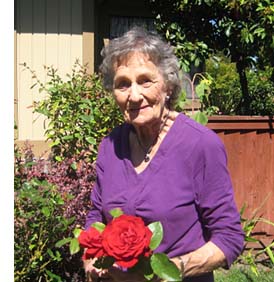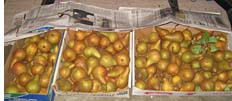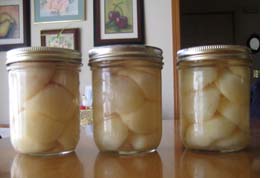How to Can Perfect Pears
- By Pia Hinckle
- Last Updated On
- Reading Time: 5 mins.

SANTA ROSA, CA—Marie Seppa knows her way around a canner. A spry 92-year-old with bright blue eyes, Marie has been canning since she was a child growing up on a farm in Eastern Oregon in the 1920s. Her specialty: pears. “All pears can, but I love Bartletts,” says Marie.
In nearly 60 years of competing in the “Canned Pears” category at the Sonoma County Fair in Northern California, she has only been beaten once. Her jars of skinned pears look like they were just cut minutes before and taste fresh and crisp, preserved in a light sugar syrup. Her secret: “You’ve got to get the fruit in as fast as possible and get the syrup on it.”
Canning, or food preservation, is the age-old process of taking fresh provisions (fruit, fish, meat, produce, legumes, etc.) and treating them in various ways to prevent spoilage and conserve for later consumption. Treatments include drying, salting, smoking, refrigerating, freezing, vacuum packing, pickling, or canning (which includes items stored in jars). Every ancient culture devised its own method of preservation that suited its climate and harvest. Anyone who has read Laura Ingalls Wilder’s Little House on the Prairie books will remember the descriptions of early 19th century familes’ efforts to preserve the harvest:

“Mother and the girls were making cucumber pickles, green-tomato pickles, and watermelon-rind pickles; they were drying corn and apples, and making preserves. Everything must be saved, nothing wasted of all the summer’s bounty. Even the apple cores were saved for making vinegar.”
—Farmer Boy, Laura Ingalls Wilder
Want farm-fresh fruit?
We've got you covered.
Marie remembers being a teenager during the Great Depression. “You would see pictures in the paper of all the people lined up at soup kitchens in the cities. It was so terrible. And here on the farm we lived like kings: we had meat and cheese from our sheep, honey from our bees so we didn’t need sugar, we had fruit and fresh vegetables of all kinds when they were growing and canned ones when they weren’t.” She said farm families also traded with other farms for what they didn’t have.
Her father, Jens Skovbo, was a Danish immigrant who was a farmer and beekeeper who settled in Hermiston, OR. He founded Skovbo Apiaries and was very active in the early national beekeeping associations. As a child, Marie would help him exhibit at county fairs in Oregon, handing out samples of her mother’s honey jelly. Their 7-acre family farm had been a pear orchard but her father later took out 5 acres of pears and planted asparagus. She learned to can from her mother who would put up pears, applesauce, asparagus, meat, and anything else on hand. Marie remembers the old “open kettle” canning method (now considered unsafe because of inconsistent temperatures) where the whole kitchen would be filled with steam.
At age 9, she joined the local 4-H club, ultimately becoming a Food Preservation Leader. When she was 19, she took a break from canning and came to California to see the 1939 World’s Fair held at Treasure Island, San Francisco. She decided to stay and was the first woman hired at Western Pacific Railroad (assistant bookkeeper). She met Emil Seppa during the War Years and they married in 1945. After moving to Petaluma (Sonoma County) with her growing family (she’s a mother of four), she started canning again and competing and winning. She said Emil loved canned fruit. “He was my best customer.” When he passed away a few years ago, she continued to can but gives most of it away. “I really prefer fresh fruit,” she says.’
Want farm-fresh fruit?
We've got you covered.

Canning is a kitchen art that is rising in popularity again, in part due to the continued economic downturn. According to a 2011 survey by allrecipes.com, 55% of American cooks planned to can this year and nearly all of them said they planned to can more than the previous year. August 13 was declared National Can-It-Forward Day and websites like Canning Across America, Little House Living, and Ball’s FreshPreserving.com are finding their traffic up. You can waste less food and stretch dollars by learning simple canning procedures.
The basic process involves preparing the produce to be preserved and placing it in sterilized glass jars, then heat-sterilizing the jars by immersion in either a boiling water bath canner (a “canner”), a steam canner (“steam canner”), or a pressure canner to kill any possible pathogens and seal the lids. What kind of canner should you use? If the food to be preserved is high-acid (fruits, tomato sauces, salsas, pickles, jams, jellies, chutneys, sauerkraut, marmalades, and fruit butter) then water or steam bath canner is fine. Vegetables, meat, poultry, and seafood are low-acid foods and should be processed in a pressure canner, which can reach a higher temperature than water and steam canners.
Want farm-fresh fruit?
We've got you covered.

Marie’s advice to people new to canning: “Start simple. Make sure the fruit is fresh and ripe. Start with applesauce. It’s easy to make and you don’t have to rush (to get it in the jar).”
Marie is a big fan of the steam canner for high-acid fruits. In 82 years of canning, she said she’s “never had a jar spoil.” They also use less water than boiling water canners but there is controversy around steam canners because a few years ago the USDA stated that their processing times hadn’t been adequately researched and deemed them unreliable, recommending hot water bath and pressure canners instead. Steam canners should only be used for high-acid foods.
For pears, Marie advises to get all your canning supplies ready ahead of time (sterilized jars and lids) and prepare the sugar syrup and lemon water. Here is her raw-packed, steam-preserved, pear canning technique:
Marie Seppa’s Canned Pears
- Ripe, but not overripe pears (preferably Bartletts)
- Peel pears first, then core and drop in a bowl of lemon water.
- Cut pears into slices and pack in jars, cover immediately with sugar syrup and seal.
- Process in hot water or steam canner according to directions.
Lemon water
(prevents browning, raises acidity)
- Mix 1 gallon of water with the juice of 1 lemon.
Sugar Syrup
(preservative)
- 4:1 water to sugar ratio. Mix sugar of your choice with water in a saucepan on medium heat until sugar dissolves. Keep warm until ready for jars.
- Follow instructions for processing time on the instructions with your canner. Don’t forget to adjust for altitude.
Cook’s note: If the pears are ripe, they have so much sugar that you don’t need more to preserve it.
Numerous websites offer canning recipes and instructions. Classes in food preservation and home canning are offered at many local community colleges. The University of Georgia offers a free online course through its National Center for Home Food Conservation.
Marie says you don’t even have to buy the fruit. “Find someone with a fruit tree. People with fruit trees always have more than they know what to do with.”
“The next best thing to enjoying fresh fruit is to enjoy the same product later in the year and to know you preserved it,” says Marie. “You can!”
(originally published October 11, 2012)
Recent Articles
Curious Where We Buy Gravenstein Apples? Meet a Farm Partner
What Are Gravenstein Apples and How Can I Order Them?
3 Expert-Approved Ways to Support Remote and Hybrid Teams
Subscribe to our Newsletter
"*" indicates required fields





